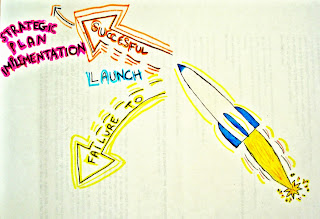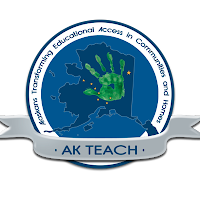In this post there are my reflections about the Kodiak Virtual Learning Conference 2015 divided in the 3 steps provided by the guidelines of this task.
Step 1:
Explain the difference in your knowledge and skills at the beginning of the conference and the end of the conference.
When I have received the first communication about the Virtual Learning Conference I was so taken by my own busy teacher's life that I did not have the chance to investigate in depth about the sessions offered by this conference. At first I was confused by not being allowed to attend to more than one strand during the two days of the conference. At that time I found this "rule" unusual and somehow unreasonable. There were at least couple of sessions that I wanted to attend and having 2 days I assumed that I could have used one day for each session. It was just during the conference that I had an epiphany understanding the very good reasoning behind the "1 session rule", and I will explain it later.
I proceeded by elimination for deciding which session to attend, trying to focus on what I could benefit the most for my professional commitment in the next school year. Although I found Natalie Freed & David Cole strand intriguing (Integrating Paper Circuitry Into Your Classroom) I felt intimidated by the description of their session, especially the words "building circuits in notebooks all the way up to introducing how to code/program circuits". In my mind the "notebook" was synonymous of laptop, and although I am a "computer literate" user, I am quite "illiterate" when it comes down to the actual electronic component of technology. Bottom line I considered this session "out of my league".
Moving to the next, Crystal Thomas was presenting Edgenuity & Blended Learning. My school district does not use Edgenuity, therefore I would have not benefit much from this session.
Sally Eberhart, Apple Trainer, was presenting a session that was catching my attention: "Getting The Most Out of Your Macbook". Although my school district is officially a PC district, Apple machines are crawling into the district. During the past year I had mini Ipads to use with my classroom students, and I used my personal Mac Notebook for editing and publishing my students IBook projects. Certainly this session could have been interesting!
Dr. Pam Loyd and John Monahan were presenting "how to build a UAV and explore how to integrate unmanned aerial vehicles into your virtual classroom". In spite of my curiosity for UAV, I could not see any practical benefit for my professional development, so I nixed this session as well.
The last session listed was "The America Bridge Project-Building Projects, Partners, & Connections" lead by Ron Fortunato. Honestly I had no idea of what this session was about, and reading the presentation of the session I did not feel any "sparks", thus I passed.
Based on my elimination process I ended up selecting the Macbook session at my time of enrollment to the conference. It was few days later that I had the opportunity to discuss my choice with Nicole Fuerst, sharing my feelings about the paper circuitry session. It was Nicole who reassured me that I did not need to be an electric engineer for participating to this session and that in her opinion I would have benefit the most from this very strand. I trusted her good judgment, and looking back I am
so grateful for her guidance! Certainly if I had taken the time to snoop around the web about paper circuitry I would have understood Nicole's advice right away, instead of during the conference...

Anyway, going back to the actual topic of this first step, I had
no clue of what I was about to do when I walked into that classroom last June 1st, and when I opened the plastic box given to each attendee, there were only 3 items I was familiar with: a pencil, a flat battery, and the scissors! :)
During David Cole and Natalie Freed opening session I started grasping some of the potentials of this technique of applying technology to crafting, creating so many versitile artifacts. Watching the video of Jie Qi interactive painging of the dendilions I felt like Alice in the Wonderland, when she fell in the rabbit's hole... so many potentials for creativity!!!
During the 2 days hands-on workshop I appreciated the rare and precious opportunity to explore more in depth a single session, having the time for practicing, creating, asking questions, making mistakes and sharing thoughts, ideas, and visions with other neofites as well as with some experts, such as David Cole, Natalie Freed, and Jie Qi who joined us via Skype from the MIT lab.
The conference did not make me an electric engineer (although I have to admit that I bragged with my husband of my playing time with electric circuits!) however it made me realize that I do not need that qualification for being able to use these circuits in very simple and creative ways with my students. Working side by side with teachers of various subjects and grade levels has been also a great experience providing a lot of ideas for creative cross curricula applications of the paper circuitry. It was so fun playing and trying to figure new ways to apply this process in various ways.
Step 2:
Explain how this experience will change your teaching practice, your administrative work, or how you support and guide colleagues.
I do not think that this experience will "change" radically my teaching practice, but it will enrich it for sure!
Talking with the other educators attending the session made me think of ways I could apply the paper circuitry technique for engaging my world languages students using more hands-on and project based approaches in my courses and branching out more to science and art field.
Mostly I feel very motivated and excited in sharing this experience and what I have learned with colleagues first in my district and later, beyond KPBSD with the goal of connecting more effectively world languages courses with Science and Art, hopefully collaborating with other teachers in creating some cross curricula projects.
I have already emailed to my admin and to our district office presenting my desire for sharing my experience with fellow educators in one day PD session during next school year.
Also I am planning to collaborate with few other teachers from other
districts (Kodiak, Ketchikan, and Juneau) for presenting a session at
first at the AFLA conference next September, and later at ASTE next year on this very topic.
Step 3:
Reflect on how you are a virtual teacher...even if you haven't previously viewed yourself that way. Why do you think it was appropriate for you to attend the conference?

I am a virtual teacher, no doubts!
I have been teaching online for 7 years now and beside last school year, I have never taught in a traditional classroom, but only via distance delivery.
Over the years I have developed various courses for French, Spanish and Italian, mostly in async mode since this is the preferential deliver offered by our district, however I have implemented more and more blended component over the years.
When I started teaching online there were not yet courses specific for online education offered in AK, so I had to learn on my own, with trial and error and direct experience. I was so leased to find out that now UAS has a program for a teaching endorsement specific for online teaching, and during the conference I had the fortune of sitting next to Dr. Grahan, who is the chair of this program. In the couple of days we were at the conference I had the chance to ask a lot of questions about the course and I am going to enroll in it next spring! I was so excited in finding out about it and the opportunity to receiving a more formally structured preparation for my type of teaching.

As for the conference itself, I think that it was a fantastic opportunity for learning something new that first can be applied directly to my teaching, but also an excellent chance to connect and keep connecting with other educators from around the state.
I do strongly believe in the power of collaboration and sharing of knowledge, ideas and reciprocal support, and what I liked the most of this conference was finding the same values being the shared in the same passionate way by both attendees and organizers...therefore I would like to say a big THANK YOU to everyone!!!













